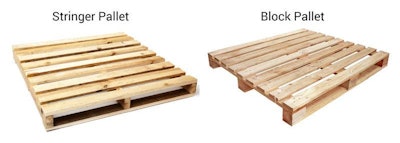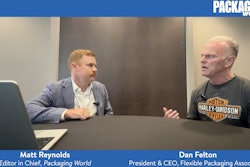In the U.S., the workhorse of CPG supply chains is the GMA (Grocery Manufacturers Association) pallet. The standardized footprint is 48 in. x 40 in., but pallet styles differ. Pallets enable efficiencies in material handling, transportation, and storage.
For most of their history, pallets were regarded as commodities—so much so that pallet management was a contradiction in terms. Back then, the wood stringer pallet ruled. The name derives from the base boards (stringers) that run the length of the pallet. The stringers are notched for fork insertion, resulting in a four-way pallet. (Stringer pallets also are called white pallets, not because they are painted but because they are not painted.)
In a bygone era, CPG companies purchased pallets, loaded them, and sent them on one-way trips. The cost of a pallet was allocated across the load and made a part of the unit price of the product. There was a built-in incentive to purchase pallets at the cheapest price, often at the expense of quality. Pallet failures were common, engendering dissatisfaction from supply chain members, especially retailers.
For decades now, pallet management has been evolving into a more complex function. The evolution coincides with a shift in supply chain leadership, from major CPG companies to major retailers. Circa mid-90s, major retailers were demanding better-performing pallets. Those retailers decided that the answer to their demand was the block pallet. Over the ensuing years, some of the giants mandated that shipments be received on block pallets. A seminal event was Costco’s Block Pallet Initiative of 2011.
Block pallets are constructed of wood. Named for the blocks in the base, they are four-way platforms. Block pallets are sturdier than stringer pallets and hold up better against the physical rigors encountered throughout supply chains.
Retailer preference for block pallets has proven to be a boon to the pallet rental industry. Supply chain specialist company CHEP, with its blue-painted pallets, controls close to a monopoly. PECO, CHEP’s competitor, supplies red-painted pallets. Both manage a pool within a closed-loop system in which pallets are delivered to user facilities, collected when empty, and finally taken to depots where they are inspected, cleaned, and repaired.
Pallet rental allows CPG companies to gain business while sidestepping the upfront outlay required with purchasing. Such benefits notwithstanding, there are a host of considerations associated with the decision. There’s the choice of rental company. The two have similar business models, but there are differences in pricing. CHEP charges a variety of fees. PECO charges a flat fee. And always important is a comparison of customer service.
Renting is not a viable option if the prospective renter cannot meet threshold quantities. Another quantity-related consideration is how the CPG company delivers to retailers that are willing to accept stringer pallets. Will the company ship to all its retailers on rented pallets or ship to non-mandating retailers on purchased pallets?
If the latter, problems might await—if not immediately, then down the road. That’s because of a chain reaction. It starts with stringer pallets losing usage to block pallet rentals. Decreased demand for stringer pallets results in decreased supply, including supply of new ones. With fewer new stringer pallets, the average age of the inventory increases. Older pallets are more prone to damage and failure. The non-mandating retailers’ customer satisfaction decreases.
There is little incentive for a CPG company to purchase new stringer pallets that will be used for a single shipment. A more practical policy is: first to deal with suppliers that have reputations for delivering good used pallets, and second to have reliable incoming inspection procedures. On a related note, CPG companies receive supplies (used in production, maintenance, etc.) on stringer pallets. There’s nothing wrong with retaining the better pallets for later use.
When shipping loads on stringer pallets and block pallets together in the same trailer (to a distribution center, for example), additional attention should be paid to blocking and bracing. Block pallets are taller than stringer pallets. When the two are abutted, the height difference can allow load contact and subsequent load sliding. It’s best to section block pallets together and stringer pallets together.
Rental block pallets are assembled with a greater degree of mechanization than is done with stringer pallets. The tighter dimensional tolerances of the former benefit a CPG company’s automated palletizing and automated storage rack systems.
None of this discussion is meant to suggest that stringer pallets will become obsolete. There is no denying, however, that their use for CPG will continue to decrease. Yes, it will be due to retailer mandates. It also will be due to the increasing diversity of categories and SKUs carried by retailers and subject to those mandates.
The time is now to acknowledge pallet management as an important component of supply chain management. Check back next month for part two on this topic, with more tips and best practices on pallet management. Specifically, I’ll discuss pallet recycling.
Sterling Anthony, CPP, is a consultant specializing in marketing, packaging, logistics, and ergonomics.
He can be reached at 100 Renaissance Center-Box 176, Detroit, MI 48243, 313/531-1875, or email him at [email protected].
























